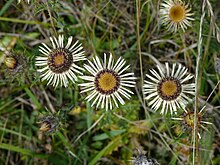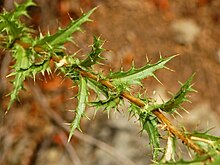
Eryngium is a genus of flowering plants in the family Apiaceae. There are about 250 species. The genus has a cosmopolitan distribution, with the center of diversity in South America. Common names include eryngo and sea holly.

Centaurea is a genus of over 700 species of herbaceous thistle-like flowering plants in the family Asteraceae. Members of the genus are found only north of the equator, mostly in the Eastern Hemisphere; the Middle East and surrounding regions are particularly species-rich. In the western United States, yellow starthistles are an invasive species. Around the year 1850, seeds from the plant had arrived to the state of California. It is believed that those seeds came from South America.

Cynara is a genus of thistle-like perennial plants in the family Asteraceae. They are native to the Mediterranean region, the Middle East, northwestern Africa, and the Canary Islands. The genus name comes from the Greek kynara, which means "artichoke".
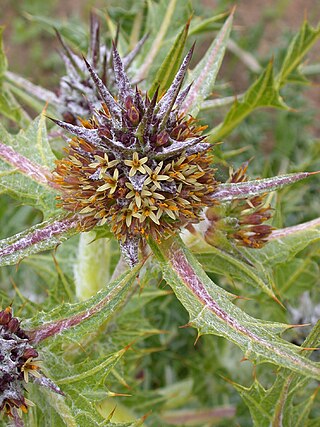
Gundelia is a low to high (20–100 cm) thistle-like perennial herbaceous plant with latex, spiny compound inflorescences, reminiscent of teasles and eryngos, that contain cream, yellow, greenish, pink, purple or redish-purple disk florets. It is assigned to the family Asteraceae. Flowers can be found from February to May. The stems of this plant dry-out when the seeds are ripe and break free from the underground root, and are then blown away like a tumbleweed, thus spreading the seeds effectively over large areas with little standing vegetation. This plant is native to the eastern Mediterranean and the Middle-East. Opinions differ about the number of species in Gundelia. Sometimes the genus is regarded monotypic, Gundelia tournefortii being a species with a large variability, but other authors distinguish up to nine species, differing in floret color and pubescence. Young stems are cooked and eaten in the Middle-East and are said to taste like a combination of artichoke and asparagus. The plant also contains compounds that have been demonstrated to be effective against a range of ailments. A large quantity of pollen assigned to Gundelia has been found on the Shroud of Turin, which may suggest that the crown of thorns was made from Gundelia.

Silybum is a genus of two species of thistles in the family Asteraceae. The plants are native to the Mediterranean regions of Europe, North Africa, and the Middle East. One species has been introduced elsewhere, including in North America. The name "milk thistle" derives from a feature of the leaves, which are prominently banded with splashes of white. Historically, these milky bands were said to be Mother Mary's milk, and this is the origin of another common name, St. Mary's thistle. The most widespread species is Silybum marianum.
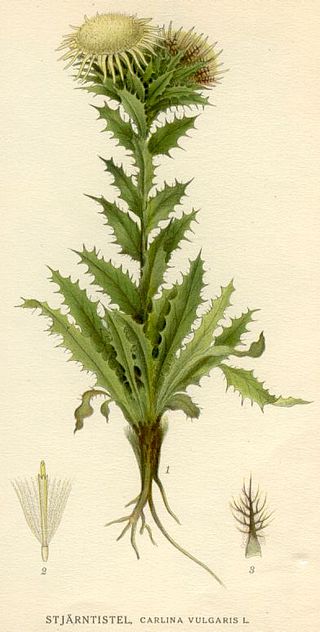
Carlina vulgaris, the carline thistle, is a plant species of the genus Carlina.

Carlina curetum is a species of the genus Carlina. It is also called carline thistle.

Onopordum, or cottonthistle, is a genus of plants in the tribe Cardueae within the family Asteraceae. They are native to southern Europe, northern Africa, the Canary Islands, the Caucasus, and southwest and central Asia. They grow on disturbed land, roadsides, arable land and pastures.

Carduus is a genus of flowering plants in the family Asteraceae, and the tribe Cardueae, one of two genera considered to be true thistles, the other being Cirsium. Plants of the genus are known commonly as plumeless thistles. They are native to Eurasia and Africa, and several are known elsewhere as introduced species. This genus is noted for its disproportionately high number of noxious weeds compared to other flowering plant genera.

Sonchus is a genus of flowering plants in the tribe Cichorieae within the family Asteraceae and are commonly known as sow thistles. Sowthistles are annual, biennial or perennial herbs, with or without rhizomes and a few are even woody.

Thistle is the common name of a group of flowering plants characterised by leaves with sharp prickles on the margins, mostly in the family Asteraceae. Prickles can also occur all over the plant – on the stem and on the flat parts of the leaves. These prickles are an adaptation that protects the plant from being eaten by herbivores. Typically, an involucre with a clasping shape similar to a cup or urn subtends each of a thistle's flower heads. The typically feathery pappus of a ripe thistle flower is known as thistle-down.
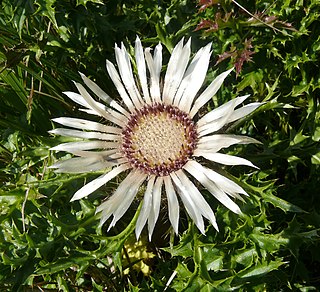
Carlina acaulis, the stemless carline thistle, dwarf carline thistle, or silver thistle, is a perennial dicotyledonous flowering plant in the family Asteraceae, native to alpine regions of central and southern Europe. The specific name acaulis and common names are descriptive of the manner in which its flower head rests directly upon a basal leaf rosette. The plant is named after Charlemagne who searched for a treatment against the plague. He dreamed of an angel who told him to shoot an arrow in the sky and see on what plant the arrow would hit. This plant would bring relieve to the plague. The plant the arrow hit was the Carlina acaulis, the roots of the plant were distributed among the population following which the plague diminished.

The Cardueae are a tribe of flowering plants in the daisy family (Asteraceae) and the subfamily Carduoideae. Most of them are commonly known as thistles; four of the best known genera are Carduus, Cynara, Cirsium, and Onopordum.
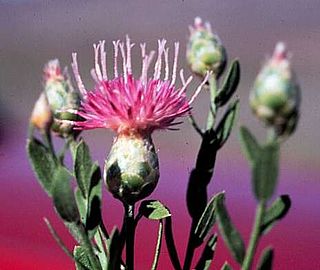
Rhaponticum is a formerly accepted genus of flowering plants in the tribe Cardueae within the family Asteraceae. As of May 2023, both Plants of the World Online and the Global Compositae Database rejected the genus in favour of Leuzea. Plants of the World Online placed all its species in that genus, apart from one unplaced species, Rhaponticum scariosum.

Cirsium douglasii is a species of thistle known by the common names Douglas' thistle and California swamp thistle.

Stenotus is a genus of flowering plants in the family Asteraceae. There are four species, all native to western North America. They are known commonly as mock goldenweeds.

Carduncellus is a genus of flowering plants in the family Asteraceae. They are native to the western Mediterranean and surrounding regions.

Notobasis syriaca, the Syrian thistle, is a species of flowering plant in the tribe Cardueae within the family Asteraceae. It is native to the Mediterranean region and the Middle East, from Madeira, the Canary Islands, Morocco and Portugal east to Egypt, Iran and Azerbaijan.
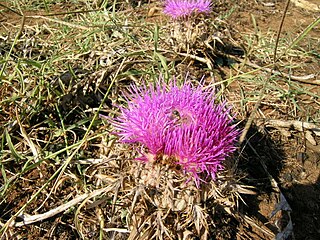
Chamaeleon gummifer, also known as distaff thistle or stemless atractylis, is a thistle in the Chamaeleon genus. Formerly, it was placed in the Atractylis genus. It is native to the Mediterranean basin, where it can be found in various habitats, including cultivated- or uncultivated fields and forests. It is a perennial herb producing a stemless, pinkish flower. The plant has a history of use in folk medicine, but it is very toxic due to the presence of atractyloside and carboxyatractyloside.
Carlina involucrata is a species of perennial herb in the family Asteraceae. They have a self-supporting growth form and broad leaves.
